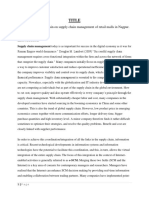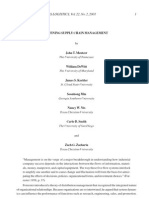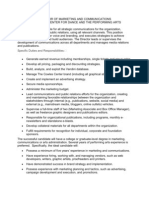Businesses Product Service Supply Chain Raw Materials
Businesses Product Service Supply Chain Raw Materials
Uploaded by
Syed Bilal MahmoodCopyright:
Available Formats
Businesses Product Service Supply Chain Raw Materials
Businesses Product Service Supply Chain Raw Materials
Uploaded by
Syed Bilal MahmoodOriginal Title
Copyright
Available Formats
Share this document
Did you find this document useful?
Is this content inappropriate?
Copyright:
Available Formats
Businesses Product Service Supply Chain Raw Materials
Businesses Product Service Supply Chain Raw Materials
Uploaded by
Syed Bilal MahmoodCopyright:
Available Formats
Supply chain management (SCM) is the management of an interconnected or interlinked between network, channel and node businesses involved
in the provision of product and service packages [2] required by the end customers in asupply chain. Supply chain management spans the movement and storage of raw materials, work-in-process inventory, and finished goods from point of origin to point of consumption. It is also defined as the "design, planning, execution, control, and monitoring of supply chain activities with the objective of creating net value, building a competitive infrastructure, leveraging [3] worldwide logistics, synchronizing supply with demand and measuring performance globally." SCM draws heavily from the areas of operations management, logistics, procurement, and information technology, and strives for an integrated approach
When did supply chain grow ?
The term "supply chain management" entered the public domain when Keith Oliver, a consultant at Booz Allen Hamilton (now Booz & Company), used it in an interview for the Financial Times in 1982. The term was slow to take hold. It gained currency in the mid-1990s, when a flurry of articles and books came out on the subject. In the late 1990s it rose to prominence as a management buzzword, and operations [5][6][7] managers began to use it in their titles with increasing regularity. Commonly accepted definitions of supply chain management include: The management of upstream and downstream value-added flows of materials, final goods, and related information among suppliers, company, resellers, and final consumers The systematic, strategic coordination of traditional business functions and tactics across all business functions within a particular company and across businesses within the supply chain, for the purposes of improving the long-term performance of the individual companies and the supply chain [8] as a whole A customer-focused definition is given by Hines (2004:p76): "Supply chain strategies require a total systems view of the links in the chain that work together efficiently to create customer satisfaction at the end point of delivery to the consumer. As a consequence, costs must be lowered throughout the chain by driving out unnecessary expenses, movements, and handling. The main focus is turned to efficiency and added value, or the end-user's perception of value. Efficiency must be increased, and bottlenecks removed. The measurement of performance focuses on total system efficiency and the equitable monetary reward distribution to those within the supply chain. The supply chain system [9] must be responsive to customer requirements." The integration of key business processes across the supply chain for the purpose of creating value [10] for customers and stakeholders (Lambert, 2008)
According to the Council of Supply Chain Management Professionals (CSCMP), supply chain management encompasses the planning and management of all activities involved in sourcing, procurement, conversion, and logistics management. It also includes coordination and collaboration with channel partners, which may be suppliers, intermediaries, third-party service providers, or customers. Supply chain management integrates supply and demand management within and across companies. More recently, the loosely coupled, self-organizing network of businesses that cooperate to provide product and service offerings has been called the Extended Enterprise.
A supply chain, as opposed to supply chain management, is a set of organizations directly linked by one or more upstream and downstream flows of products, services, finances, or information from a source to [8] a customer. Supply chain management is the management of such a chain. Supply chain management software includes tools or modules used to execute supply chain transactions, manage supplier relationships, and control associated business processes. Supply chain event management (SCEM) considers all possible events and factors that can disrupt a supply chain. With SCEM, possible scenarios can be created and solutions devised. In many cases the supply chain includes the collection of goods after consumer use for recycling. Including third-party logistics or other gathering agencies as part of the RM re-patriation process is a way of illustrating the new endgame strategy.
Impact on the world
Organizations increasingly find that they must rely on effective supply chains, or networks, to compete in [11] the global market and networked economy. In Peter Drucker's (1998) new management paradigms, this concept of business relationships extends beyond traditional enterprise boundaries and seeks to organize entire business processes throughout a value chain of multiple companies. In recent decades, globalization, outsourcing, and information technology have enabled many organizations, such as Dell and Hewlett Packard, to successfully operate collaborative supply networks in which each specialized business partner focuses on only a few key strategic activities (Scott, 1993). This inter-organisational supply network can be acknowledged as a new form of organisation. However, with the complicated interactions among the players, the network structure fits neither "market" nor "hierarchy" categories (Powell, 1990). It is not clear what kind of performance impacts different supply network structures could have on firms, and little is known about the coordination conditions and trade-offs that may exist among the players. From a systems perspective, a complex network structure can be decomposed into individual component firms (Zhang and Dilts, 2004). Traditionally, companies in a supply network concentrate on the inputs and outputs of the processes, with little concern for the internal management working of other individual players. Therefore, the choice of an internal management control structure is known to impact local firm performance (Mintzberg, 1979).
In the 21st century, changes in the business environment have contributed to the development of supply chain networks. First, as an outcome of globalization and the proliferation of multinational companies, joint ventures, strategic alliances, and business partnerships, significant success factors were identified, complementing the earlier "just-in-time", lean manufacturing, and agile [12] manufacturing practices. Second, technological changes, particularly the dramatic fall in communication costs (a significant component of transaction costs), have led to changes in coordination among the members of the supply chain network (Coase, 1998). Many researchers have recognized supply network structures as a new organisational form, using terms such as "Keiretsu", "Extended Enterprise", "Virtual Corporation", "Global Production Network", and "Next [13] Generation Manufacturing System". In general, such a structure can be defined as "a group of semiindependent organisations, each with their capabilities, which collaborate in ever-changing constellations to serve one or more markets in order to achieve some business goal specific to that collaboration" (Akkermans, 2001). The security management system for supply chains is described in ISO/IEC 28000 and ISO/IEC 28001 and related standards published jointly by the ISO and the IEC.
Green Supply change management
Supply chain management and the environment For years the producers responsibilities were finished when the product was on the shelves in the shop or when the guarantee period was over. Supply chain (SC) management was perceived as the planning and control of the flow of goods from the sourcing base to the final consumers, accompanied with the necessary information and money for the independent entities along that chain. Traditional supply chain management focuses on low cost, high quality, reduced lead time and high service level. The introduction of the Extended Producer Responsibility in a number of countries and industries has changed the rules of the market behaviours. Nowadays manufacturers need to take into consideration the post-consumption phase of their products, the so called end-of-life phase (EOL): the environmental burdens incurred during different stages of the product transfer from manufacturer to final user and then to the disposal site. The interest in environmentally friendly supply chain management has risen considerably in recent years. This can be seen by the number of initiatives taken by companies. Brand-owners are very often perceived to be responsible for environmental problems in the entire supply chain from to the sourcing base to end-of-life recovery issues. It is expected that the manufacturers should reduce sources of waste and pollution throughout their entire SCs, across multiple entities, upstream (suppliers) and downstream (distributors and consumers). An environmentally friendly supply chain connects with partners who should make managerial decisions with regard to environmental consequences. It enhances competitiveness and creates better customer service, resilience and increased profitability.
Green SCM can reduce the ecological impact of industrial activity without sacrificing quality, cost, reliability, performance or energy utilization efficiency, meeting environmental regulations to not only minimize ecological damage but also to ensure overall economic profit.
You might also like
- Detailed Lesson Plan On EconomicsDocument6 pagesDetailed Lesson Plan On EconomicsArchill Yapparcon92% (26)
- Capacity Training PDFDocument103 pagesCapacity Training PDFKaya Eralp Asan100% (2)
- Pset 1Document5 pagesPset 1KennethFuNo ratings yet
- Supply Chain Management - Wikipedia, The Free EncyclopediaDocument11 pagesSupply Chain Management - Wikipedia, The Free EncyclopediaKptt LogeswaranNo ratings yet
- Supply Chain ManagementDocument10 pagesSupply Chain ManagementAnnie CaserNo ratings yet
- Supply Chain ManagementDocument14 pagesSupply Chain ManagementGauravDaveNo ratings yet
- Supply-Chain Management - Wikipedia PDFDocument128 pagesSupply-Chain Management - Wikipedia PDFKambiz sutoodaNo ratings yet
- Supply Chain ManagementDocument16 pagesSupply Chain ManagementLynnyth SahilanNo ratings yet
- Mission: Oscar GomesDocument3 pagesMission: Oscar GomesnidayousafzaiNo ratings yet
- POMDocument14 pagesPOMKiran ThapaNo ratings yet
- Supply Chain Management - EmmaDocument39 pagesSupply Chain Management - EmmaEmmanuel BasseyNo ratings yet
- Rintu SeminarDocument9 pagesRintu SeminarRenjith NgNo ratings yet
- Supply Chain Management SummaryDocument18 pagesSupply Chain Management SummaryrangacharyNo ratings yet
- Supply Chain ManagementDocument15 pagesSupply Chain ManagementMehak GuptaNo ratings yet
- Supply Chain Management A ReportDocument20 pagesSupply Chain Management A ReportjyotirmayeenaikNo ratings yet
- Supply Chain ManagementDocument98 pagesSupply Chain Managementtest1217100% (1)
- Paraamm Supply Chain ManagementDocument50 pagesParaamm Supply Chain ManagementParamvir DhotNo ratings yet
- O o o o o o o O: Citation Needed When?Document12 pagesO o o o o o o O: Citation Needed When?Sunny GoyalNo ratings yet
- Supply Chain ManagementDocument26 pagesSupply Chain ManagementHardikMavaniNo ratings yet
- Supply Chain ManagementDocument7 pagesSupply Chain Managementklumba2027No ratings yet
- Logistics ManagementDocument6 pagesLogistics ManagementAntony SatheshNo ratings yet
- Supply Chain Principles and ApplicationsDocument12 pagesSupply Chain Principles and ApplicationsRicky KristandaNo ratings yet
- Unit 2 - OR & Supply Chain - 1725345245Document20 pagesUnit 2 - OR & Supply Chain - 1725345245Praveen LobaniyaNo ratings yet
- Supply Chain ManagementDocument6 pagesSupply Chain ManagementSheikh Saad Bin ZareefNo ratings yet
- Supply Chain: From Wikipedia, The Free EncyclopediaDocument4 pagesSupply Chain: From Wikipedia, The Free EncyclopediaAhmed Noor KhawajaNo ratings yet
- Recent Development in The Field of SCM by Nimisha NandanDocument24 pagesRecent Development in The Field of SCM by Nimisha NandanDr. Nimisha Nandan100% (2)
- MZU-SEM I-MBA-Fundamentals of Logistics and Supply Management-Unit 2Document37 pagesMZU-SEM I-MBA-Fundamentals of Logistics and Supply Management-Unit 2Rahul GoudaNo ratings yet
- Supplier Customer Raw Materials Value ChainsDocument44 pagesSupplier Customer Raw Materials Value ChainsniyaramakrishnanNo ratings yet
- MSCM 1663 Supply Chain Modeling: Assignment 1Document10 pagesMSCM 1663 Supply Chain Modeling: Assignment 1Choy BeiyeeNo ratings yet
- Supply Chain MGMT Final-105Document40 pagesSupply Chain MGMT Final-105Nilesh JetaniNo ratings yet
- Supply Chain ManagementDocument15 pagesSupply Chain Managementsaif125No ratings yet
- Impact of E-Supply Chain On Supply Chain Management of Retail Malls in Nagpur. (SYNOPSIS)Document11 pagesImpact of E-Supply Chain On Supply Chain Management of Retail Malls in Nagpur. (SYNOPSIS)Deepak Singh100% (2)
- Black Book ProjectDocument55 pagesBlack Book ProjectTrupti Kuvalekar75% (4)
- Supply Chain Management-Historical PerspectiveDocument7 pagesSupply Chain Management-Historical PerspectiveTalha SaeedNo ratings yet
- Significance: Diamond CutterDocument4 pagesSignificance: Diamond CutterMuhammad Ahmed RaoNo ratings yet
- Supply Chain MGMT Project1Document40 pagesSupply Chain MGMT Project1arvind_vandanaNo ratings yet
- Special Research Focus On Supply Chain LDocument16 pagesSpecial Research Focus On Supply Chain LAKSHAT GHATIANo ratings yet
- Gaining Competitive Advantages Through Supply Chain Management: Success StoriesDocument8 pagesGaining Competitive Advantages Through Supply Chain Management: Success StoriesLijo M LoyidNo ratings yet
- Building The Resilient Supply ChainDocument29 pagesBuilding The Resilient Supply ChainJrojetroc RodericNo ratings yet
- InTech-Supply Chain Management SCM Theory and EvolutionDocument13 pagesInTech-Supply Chain Management SCM Theory and EvolutionRahat KhanNo ratings yet
- Review of LiteratureDocument12 pagesReview of LiteratureeswariNo ratings yet
- Supply Chain IntegrationDocument5 pagesSupply Chain IntegrationnithiyaranjiniNo ratings yet
- Supply Chain Management in Glass IndustryDocument58 pagesSupply Chain Management in Glass IndustrySahil Maini50% (2)
- Contributions of Supply Chain ManagementDocument7 pagesContributions of Supply Chain ManagementAditya Srivastava100% (1)
- Defining Supply Chain ManagementDocument7 pagesDefining Supply Chain ManagementVampyPhanNo ratings yet
- Defining Supply Chain ManagementDocument25 pagesDefining Supply Chain ManagementremylemoigneNo ratings yet
- BRP - Supply Chain ModellingDocument15 pagesBRP - Supply Chain ModellingNikit Chaudhary100% (1)
- Collaboration Between Supply ChainsDocument42 pagesCollaboration Between Supply Chainsahmed100% (1)
- Supply Chain ManagementDocument121 pagesSupply Chain ManagementNSDC AddonsNo ratings yet
- Modeling Supply Chain Dynamics: A Multiagent Approach: Jayashankar M. SwaminathanDocument26 pagesModeling Supply Chain Dynamics: A Multiagent Approach: Jayashankar M. SwaminathanalamataNo ratings yet
- Strategic Capability Response Analysis: The Convergence of Industrié 4.0, Value Chain Network Management 2.0 and Stakeholder Value-Led ManagementFrom EverandStrategic Capability Response Analysis: The Convergence of Industrié 4.0, Value Chain Network Management 2.0 and Stakeholder Value-Led ManagementNo ratings yet
- Supply Chain Management EssayDocument18 pagesSupply Chain Management EssayChris Ba Aiden Mabuwa100% (1)
- 1 PDFDocument29 pages1 PDFHardik GuptaNo ratings yet
- Military Supply Chain Management: From Deployment to Victory, Mastering the Logistics DanceFrom EverandMilitary Supply Chain Management: From Deployment to Victory, Mastering the Logistics DanceNo ratings yet
- Strategic Procurement From Cost-Cutting To Competitive AdvantageFrom EverandStrategic Procurement From Cost-Cutting To Competitive AdvantageNo ratings yet
- Optimal Control and Optimization of Stochastic Supply Chain SystemsFrom EverandOptimal Control and Optimization of Stochastic Supply Chain SystemsNo ratings yet
- Dancing on a Cloud: A Framework for Increasing Business AgilityFrom EverandDancing on a Cloud: A Framework for Increasing Business AgilityNo ratings yet
- Driving Service Productivity: Value-Creation Through InnovationFrom EverandDriving Service Productivity: Value-Creation Through InnovationNo ratings yet
- The Road to Servitization: How Product Service Systems Can Disrupt Companies’ Business ModelsFrom EverandThe Road to Servitization: How Product Service Systems Can Disrupt Companies’ Business ModelsNo ratings yet
- Capital Equipment Purchasing: Optimizing the Total Cost of CapEx SourcingFrom EverandCapital Equipment Purchasing: Optimizing the Total Cost of CapEx SourcingNo ratings yet
- Erp Life Cycle Phases Final PresentationDocument24 pagesErp Life Cycle Phases Final PresentationSyed Bilal MahmoodNo ratings yet
- Chapter 2: System StructuresDocument41 pagesChapter 2: System StructuresSyed Bilal MahmoodNo ratings yet
- Risk Management in SoftwareDocument14 pagesRisk Management in SoftwareSyed Bilal MahmoodNo ratings yet
- Human Resources & It's ImpactDocument36 pagesHuman Resources & It's ImpactSyed Bilal MahmoodNo ratings yet
- CustomDocument18 pagesCustomavinishNo ratings yet
- Krishna HSBC 20-21 StatementDocument175 pagesKrishna HSBC 20-21 StatementSumit VermaNo ratings yet
- ENGLISH00 T 0 Logistics 0 P127403Document53 pagesENGLISH00 T 0 Logistics 0 P127403Ezana EzanaNo ratings yet
- The Effects of Social Spending On Economic Activity: Empirical Evidence From A Panel of OECD CountriesDocument30 pagesThe Effects of Social Spending On Economic Activity: Empirical Evidence From A Panel of OECD CountriesCristian Alejandro Lopez VeraNo ratings yet
- FORM T R 30 Contingency BillDocument4 pagesFORM T R 30 Contingency BillEmployment Exchange SITENo ratings yet
- Ebay QuestionDocument3 pagesEbay QuestionIndharta HarviansyahNo ratings yet
- Cost Sheet - Pages 16Document16 pagesCost Sheet - Pages 16omikron om0% (1)
- Information Sheet 4. Identify Different Types of CustomersDocument21 pagesInformation Sheet 4. Identify Different Types of CustomersPagda ngananNo ratings yet
- Introduction To Foreign ExchangeDocument36 pagesIntroduction To Foreign Exchangedhruv_jagtap100% (1)
- Effects of Industrial RevolutionDocument3 pagesEffects of Industrial RevolutionIzuShiawaseNo ratings yet
- Complete English Batch Reading Comprehension: English by Vishal PariharDocument35 pagesComplete English Batch Reading Comprehension: English by Vishal PariharKartik VermaNo ratings yet
- Free ESG CoursesDocument7 pagesFree ESG CoursesSandi RRNo ratings yet
- Eight Areas of WasteDocument18 pagesEight Areas of WasteMelody Altubar-Beato100% (1)
- Accounting Standard Notes by Anand R. BhangariyaDocument96 pagesAccounting Standard Notes by Anand R. BhangariyaSanjana SharmaNo ratings yet
- FOREX SSG Trading SystemDocument5 pagesFOREX SSG Trading SystemMohammad Akbar BalochNo ratings yet
- Learning Activity Sheet Fundamentals of Accountancy Business and Management 2 Quarter 1 - Week 1Document14 pagesLearning Activity Sheet Fundamentals of Accountancy Business and Management 2 Quarter 1 - Week 1Dhee SulvitechNo ratings yet
- Chapter 1Document2 pagesChapter 1Janelle Khoo Pei XinNo ratings yet
- CowlesCenter Director Marketing CommunicationsDocument2 pagesCowlesCenter Director Marketing CommunicationsLars LeafbladNo ratings yet
- RetirementDocument11 pagesRetirementRamesha GangannaNo ratings yet
- Dissertation On Investment AppraisalDocument9 pagesDissertation On Investment AppraisalPaperWriterUK100% (2)
- PCD Pharma Franchise ChhattisgarhDocument13 pagesPCD Pharma Franchise ChhattisgarhUpasana BalaNo ratings yet
- A Business Plan FrameworkDocument8 pagesA Business Plan FrameworkJaweria RasoolNo ratings yet
- First Exam 50 ItemsDocument3 pagesFirst Exam 50 ItemsEDLYN MABUTINo ratings yet
- Outsourcing: Croatian and World Practice: II. WIFI International Logistics ForumDocument29 pagesOutsourcing: Croatian and World Practice: II. WIFI International Logistics ForumDamira KalačNo ratings yet
- Probability Concept and Application (Exercise Answer)Document14 pagesProbability Concept and Application (Exercise Answer)LokaNo ratings yet
- Debt or Equity-Which One Is Better For Your Business?: Name-Avani Shah Roll No-Pgdmrba019Document2 pagesDebt or Equity-Which One Is Better For Your Business?: Name-Avani Shah Roll No-Pgdmrba019avani shahNo ratings yet
- Improving Performance Through Business Process ManagementDocument4 pagesImproving Performance Through Business Process ManagementArk Group0% (1)





























































































